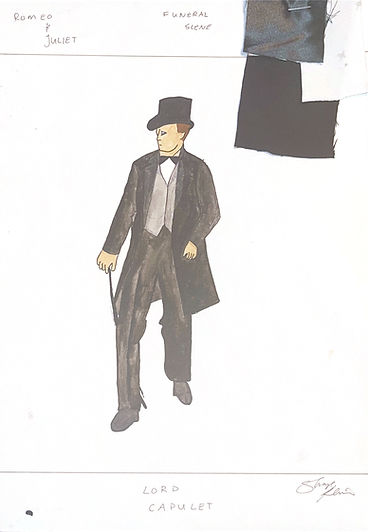Basics of Production Design - Romeo and Juliet Costuming
My sophomore year of college, per my major, I took a course called Basics of Production Design, in which I learned many things regarding how theater productions work. This included doing work as an assistant stage manager, learning how to sew, learning how lights worked (and how they were installed), sound design, and costuming.
The assignment given for costuming was: pick one of two scenes from Romeo and Juliet for each character, and, in the style of the 1900s clothing, design costumes for these five characters: Romeo, Juliet, Lord Capulet, Lady Capulet, and the Nurse. Included in this assignment, not only did we have to design costumes, we had to choose specific pieces of fabric that we thought would closely resemble the image we had in our minds of what these costumes would look like. With our drawings, we had to include those snippets of fabric for a tactical, visible example of our imagination/creation.
(Apologies for the white backgrounds, these drawings were done on white watercolor paper, making the contrast seem more distinct that it is after being scanned.)

01
Romeo
In class, we were provided several textbooks full of ideas that gave examples of fashion through the ages. Both men's and women's fashion were included.
The fabric I chose for Romeo, during Act 2 Scene 1, correlates to his jacket, undershirt, and stockings & garters. The reddish/brown fabric is a gabardine that is consistent throughout his trousers, jacket, and hat. The other two black and white fabrics are cotton.
I drew this figure from reference. Then I painted his costume with watercolor and colored pencils.
02
Juliet
My image for this dress, for Juliet in the ballroom scene, was that it would be very feminine and filled with lace and gauze. It is hard to see in this photo. but underneath the two shades of blue lace, there is a white slip of fabric with a pattern of a flower and leaves. That would be the base fabric beneath the gauzy layer. The bodice of her dress, as well as the hem at the bottom, would have the white fabric as a base with the lace covering it completely.
I drew this figure from reference, then used watercolors, colored pencils, and pens to add the details.


03
Lord Capulet
I chose a basic early 1900's suit attire for Lord Capulet to wear during the funeral scene. The bottom black fabric is the color of his tie as well as his hat. The top, shinier black fabric is the material that would be used for his vest, coat, and trousers. The white fabric is for his undershirt.
I drew this figure and used watercolor paint to add the details--such as the light sheen of his trousers that would reflect the type of fabric used. I also added a cane/walking stick.
04
Lady Capulet
Lady Capulet's dress was the most detailed one for me to complete. There were several pieces of fabric that I had chosen for her funeral garb. The lace swatch at the bottom is to be the netting covering her face, as many women would wear when in mourning; the lace is also for the pieces on the slit of her dress and the rim of her shawl. Then, the dark, navy blue swatch indicates the blue highlights on the slit of her dress, the several others around her shawl, and the bow on her hat. The darker (non-shiny) black fabric is the main fabric for the entirety of her dress. The shinier black is meant for her sleeves, hat, and underside of her shawl.
In the details when painting, I gave Lady Capulet some flowers on her hat, rosary beads at her waist, and a walking stick.


05
Nurse
The scene I chose for the Nurse is Act 3, Scene 2. In this scene, she would be wearing a blue dress (due to the scanning of the drawing, the dark fabric looks black, but is indeed a dark navy blue). The smaller details of the Nurse's dress, such as the belt, neckline, shoulders, and wrists, would be accentuated with a white fabric overlayed with blue lace.
I only used one example of lace, but as shown with the painted details, there are differences in terms of which patterns are used where throughout the dress. The swatch shown in the image would be used for the details at her shoulders and wrists. Two different patterns could be used for the belt and the neckline.